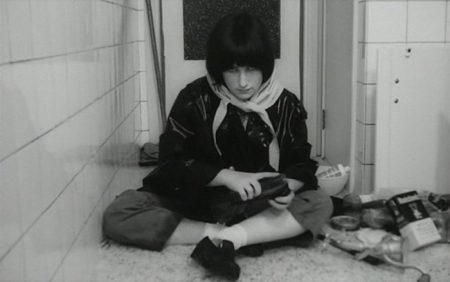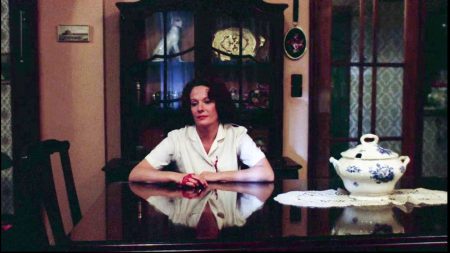The work of Belgian filmmaker Chantal Akerman has received no scarcity of praise. Akerman is considered one of the more influential feminist filmmakers to emerge from Europe in the 70s and her film Jeanne Dielman 23, quai du Commerce 1080 Bruxelles is particularly iconic. I’ve always found Akerman’s acclaim fascinating because she exists sort of in between the Avant Garde and traditional art house film. Her work blurs the line between moving pictures and the photographic arts – indeed Akerman took shots from many of her films and turned them into gallery installations. Jeanne Dielman, in particular, uses much of its three hour and twenty-one minutes encouraging the viewer to engage with long, still, meticulously crafted shots of the protagonist’s Brussels apartment.
With the extra time on my hands, I’ve been revisiting some of Akerman’s work recently and thinking about some of it in new terms. Currently the Criterion Channel is streaming two films, No Home Movie and Dis-Moi, for a limited time in addition to seven mainstays. Jeanne Dielman is available for free through Kanopy and many of her shorter films are easily found on various sites like YouTube. Her work consistently examines alienation and isolation as well as the confines of physical space and the female body. It should come as no surprise that her work resonates now. Her solitary characters – whether they’re walking down an empty city street, or cooped up in an apartment – are compelling, sometimes cathartic, quarantine companions.
The notable Hotel Monterey and New From Home are both wonderfully meditative explorations of an artist gradually growing comfortable in a new space (she made them upon arriving in New York to study Avant Garde film). In 1968 the 18 year old Akerman made her first film Saute ma ville (a much shorter spiritual precursor to Jeanne Dielman), which depicts a young woman (Akerman herself), wreaking havoc in a cramped kitchen. With an anarchistic whimsy, the girl dances, sings and scatters dishes and mop water all over the floor while she seals the doors and windows and turns on the gas stove to kill herself. I can’t say I haven’t had days like this recently (minus the death part, of course). It’s a youthful feminist rebuke of norms that keep women in the kitchen whereby she recognizes her restrictions and chooses absolute freedom rather than cooperation with them. She recognizes that her body is expected to be restrained by domesticity and chooses to free her spirit. It’s a juvenile 13 minutes, but its primary themes of the body (which fully form in Jeanne Dielman), serve as haunting reminders of how our worst norms have endured – especially during this time in which the biopolitical language of essential and service workers masks the fact that the bodies of the marginalized and lower classes are being compromised to support flawed, oppressive power structures.
Jeanne Dielman, which she made 7 seven years later at just 25, lacks the brevity and the whimsy of Saute ma ville. Conversely, in its somewhat surprising maturity, it uses time and spatial constraint to make creeping feminist and Marxist gestures about the biopolitics of the female body, domesticity and work. Theories of biopolitics sprouted from Michel Foucault’s work in “The History of Human Sexuality” and have since evolved in different ways. I use the term here to refer to how societal norms shape the usage of the body. Generally, norms are meant to protect the general body politic or the perceived health of a society’s population. When a member of that body politic becomes either a threat or less important to society, their bodies are demoted, leading to a sacrifice or change in usage of the body. In this case Jeanne Dielman (played by Delphine Seyrig) sells sex in order to maintain the façade of a reputable housewife. She tends to seemingly routine activities like cleaning, bathing, cooking and polishing shoes. She sends her teenaged son to school and dines with him in the evening. As a single mother, she spends a window of each afternoon prostituting herself for financial compensation. The next day she does it all again, until on the third day she snaps, stabbing a john in the neck with a pair of scissors.
As I’ve noted, the longevity of the film forces viewers to linger on still frames, sometimes for minutes at a time. Though Jeanne and her son may be moving within the frames, the movement is so minimal that sometimes watching feels akin to observing a photo in a gallery for a few minutes. One shot shows Jeanne contemplatively sitting at her small kitchen table. As seconds tick, viewers might notice that the table is clean and clear like the rest of the kitchen. Only a pot sits on the stove as potatoes cook. The curtains are pulled open in perfect symmetry. The leg of the table is perfectly aligned with the break between two windows. Importantly, the camera peers in from slightly outside of the doorframe. Rather than being inside of the kitchen with Jeanne, she sits isolated in her designated space, which alludes to the alienation of her character. During these long durations, Akerman’s camera gradually reveals the cracks in the façade, and the exhaustion that accompanies upholding it.
Late in the film, before the last john arrives, Jeanne sits exhausted in the living room for a few minutes. The decorative wallpaper is beautiful. The vase of yellow flowers sits perfectly in the middle of the coffee table while a small remote aligns perfectly with the edge of the table. It’s clear that the action we observe, though seemingly routine, is actually a meticulously orchestrated attempt at maintaining appearances and fulfilling the housewife role. The lack of a father figure or significant other, and the juxtaposition of her household duties with prostitution allude to something darker and more mysterious. Within the biopolitical framework we might read Jeanne, single mother, as a threat to the domestic order. The fact that she has to prostitute herself highlights the need for the patriarch to make prescribed domestic modes function. It also highlights that there is no room for a woman like her in the traditional economic order, she is alienated precisely by the efforts she makes to be included within the dominant social order.
Akerman also invokes alienation in the scenes with other people, which boil down to interactions with her sons and johns. Regardless of the activity that takes place between them, there seems to be a social barrier. When they eat dinner, her son reads and Jeanne says, “no reading at the dinner table.” He puts his book down and they sit in silence until she forces an interaction about school or an aunt. It doesn’t make much of a difference if he’s reading or not. They fulfill their familial duties without engaging in much, if any, authentic emotional connection or bonding.
Any scene involving a john confirms that she does not, in fact, want to actually be having sex with them (an important distinction to make because sex work isn’t always necessarily practiced out of sacrifice or forced circumstances). The final scene in particular, which leads to her murdering him, demonstrates the great discomfort that she feels in the acts. If she enjoys sex, clearly none of what she engages in here qualifies. What she does is purely work. She engages in a biopolitics of the female body by selling her body for sex. The juxtaposition with her household duties indicates that she does it because she has to. Never mind how she pays for the apartment; the decoration of the living room shows clearly that she is an exemplary housewife. The dual nature of her life shows that she engages in something she doesn’t want to in order to bolster biopolitical domesticity. By upholding those values she’s able to show that she isn’t a threat to the body politic, and can hopefully benefit from societal order (though as I’ve argued, her alienation is a side effect).
Though the length of the film can wear on the viewer, the true power of watching her routines comes precisely from that length. Akerman avoids didacticism, rather using realism to make the viewer feel the time pass as Jeanne Dielman does herself. When she finally kills the third john, we’ve felt her work. The classically feminist message of smashing the patriarchy is on full display, though it resonates more than ever – we’ve lived it with her. Even in pre-Covid times, I think the act of watching her slogging through the tedium of work that saves face is a compelling reminder of just how futile it can all feel. When essential and service workers go to their restaurants and stores, they will have to trust that the people they serve – many of whom can work from home – will respect their health enough to maintain a safe distance. When Jeanne allows johns into her personal home (before cracking), she must trust that they’ll respect her boundaries. The final shot of Jeanne, which Akerman converted into an installation called “Woman Sitting After Killing,” is a fascinatingly ambiguous meditation that oscillates between relief, fear and ecstasy. Viewers might interpret her meditation as being aware that there will be consequences yet relishing in the satisfaction of the act. This is not to say that feminists and essential workers should go around murdering people, but it is to say that they should not keep their gripes about their roles in the biopolitical order quiet. As we slog through this crisis period in which the flaws in our systems and their values are glaringly apparent, it’s reasonable to push for personal and political action.
–Josh Beckelhimer




